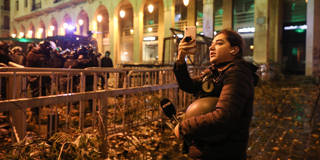Egypt and Saudi Arabia have shown that, when a government lacks legitimacy, its best chance of holding onto power is by suppressing unfavorable information. But the experiences of Iraq and Lebanon suggest that this approach has limits in political systems that depend on power-sharing arrangements.
SYDNEY – Since 2018, large antigovernment protests – what some term the Arab Spring 2.0 – have reverberated across the Middle East. Protesters decry corruption, sectarianism, and economic stagnation. Like the Arab uprisings a decade ago, these protests have successfully unseated key leaders – prime ministers have resigned in Lebanon, Iraq, and Jordan, and long-term dictators were toppled in Sudan and Algeria.
In 2011, protests died down after leaders were forced out. But this time, they have continued, highlighting the region’s crisis of governance and citizenship, which cannot adequately be addressed by rotating the head on a dysfunctional body politic.
Government forces and associated militias in Iraq and Lebanon have attempted to quash protests through violence and intimidation, but protesters have remained undeterred. As a result, the authorities in these countries have turned to the example of the region’s more authoritarian governments, like Egypt and Saudi Arabia. Both have managed to quell active dissent more successfully – at least for the time being – through aggressive media suppression and information manipulation, in addition to violent repression and arrests. For these countries’ leaders, the permissive media and information environment was responsible for the protests that rocked the Arab world in 2011.

SYDNEY – Since 2018, large antigovernment protests – what some term the Arab Spring 2.0 – have reverberated across the Middle East. Protesters decry corruption, sectarianism, and economic stagnation. Like the Arab uprisings a decade ago, these protests have successfully unseated key leaders – prime ministers have resigned in Lebanon, Iraq, and Jordan, and long-term dictators were toppled in Sudan and Algeria.
In 2011, protests died down after leaders were forced out. But this time, they have continued, highlighting the region’s crisis of governance and citizenship, which cannot adequately be addressed by rotating the head on a dysfunctional body politic.
Government forces and associated militias in Iraq and Lebanon have attempted to quash protests through violence and intimidation, but protesters have remained undeterred. As a result, the authorities in these countries have turned to the example of the region’s more authoritarian governments, like Egypt and Saudi Arabia. Both have managed to quell active dissent more successfully – at least for the time being – through aggressive media suppression and information manipulation, in addition to violent repression and arrests. For these countries’ leaders, the permissive media and information environment was responsible for the protests that rocked the Arab world in 2011.